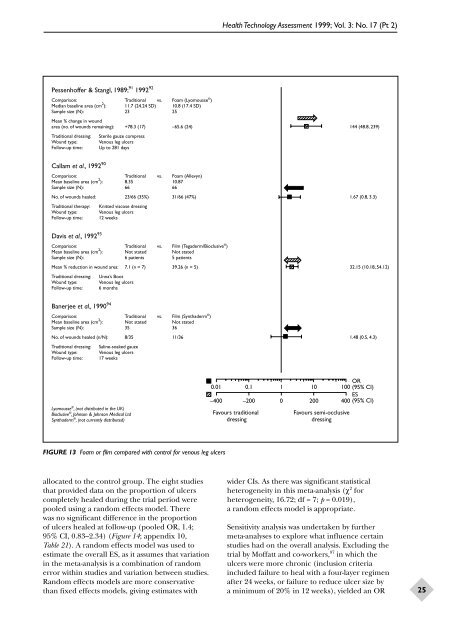Dressings and Topical Agents for Chronic Wounds - NIHR Health ...
Dressings and Topical Agents for Chronic Wounds - NIHR Health ...
Dressings and Topical Agents for Chronic Wounds - NIHR Health ...
You also want an ePaper? Increase the reach of your titles
YUMPU automatically turns print PDFs into web optimized ePapers that Google loves.
<strong>Health</strong> Technology Assessment 1999; Vol. 3: No. 17 (Pt 2)Pessenhoffer & Stangl, 1989; 91 1992 92Comparison: Traditional vs. Foam (Lyomousse ® )Median baseline area (cm 2 ): 11.7 (24.24 SD) 10.8 (17.4 SD)Sample size (N): 23 25Mean % change in woundarea (no. of wounds remaining): +78.3 (17) –65.6 (24) 144 (48.8, 239)Traditional dressing: Sterile gauze compressWound type: Venous leg ulcersFollow-up time: Up to 281 daysCallam et al., 1992 90Comparison: Traditional vs. Foam (Allevyn)Mean baseline area (cm 2 ): 8.35 10.87Sample size (N): 66 66No. of wounds healed: 23/66 (35%) 31/66 (47%) 1.67 (0.8, 3.3)Traditional therapy: Knitted viscose dressingWound type: Venous leg ulcersFollow-up time: 12 weeksDavis et al., 1992 93Comparison: Traditional vs. Film (Tegaderm/Bioclusive ® )Mean baseline area (cm 2 ): Not stated Not statedSample size (N): 6 patients 5 patientsMean % reduction in wound area: 7.1 (n = 7) 39.26 (n = 5) 32.15 (10.18, 54.12)Traditional dressing: Unna’s BootWound type: Venous leg ulcersFollow-up time: 6 monthsBanerjee et al., 1990 94Comparison: Traditional vs. Film (Synthaderm ® )Mean baseline area (cm 2 ): Not stated Not statedSample size (N): 35 36No. of wounds healed (n/N): 8/35 11/36 1.48 (0.5, 4.3)Traditional dressing: Saline-soaked gauzeWound type: Venous leg ulcersFollow-up time: 17 weeksLyomousse ® , (not distributed in the UK)Bioclusive ® , Johnson & Johnson Medical LtdSynthaderm ® , (not currently distributed)0.01 0.1 1 10 100 OR(95% CI)ES–400 –200 0 200 400 (95% CI)Favours traditionaldressingFavours semi-occlusivedressingFIGURE 13 Foam or film compared with control <strong>for</strong> venous leg ulcersallocated to the control group. The eight studiesthat provided data on the proportion of ulcerscompletely healed during the trial period werepooled using a r<strong>and</strong>om effects model. Therewas no significant difference in the proportionof ulcers healed at follow-up (pooled OR, 1.4;95% CI, 0.83–2.34) (Figure 14; appendix 10,Table 21). A r<strong>and</strong>om effects model was used toestimate the overall ES, as it assumes that variationin the meta-analysis is a combination of r<strong>and</strong>omerror within studies <strong>and</strong> variation between studies.R<strong>and</strong>om effects models are more conservativethan fixed effects models, giving estimates withwider CIs. As there was significant statisticalheterogeneity in this meta-analysis (χ 2 <strong>for</strong>heterogeneity, 16.72; df = 7; p = 0.019),a r<strong>and</strong>om effects model is appropriate.Sensitivity analysis was undertaken by furthermeta-analyses to explore what influence certainstudies had on the overall analysis. Excluding thetrial by Moffatt <strong>and</strong> co-workers, 97 in which theulcers were more chronic (inclusion criteriaincluded failure to heal with a four-layer regimenafter 24 weeks, or failure to reduce ulcer size bya minimum of 20% in 12 weeks), yielded an OR25
















